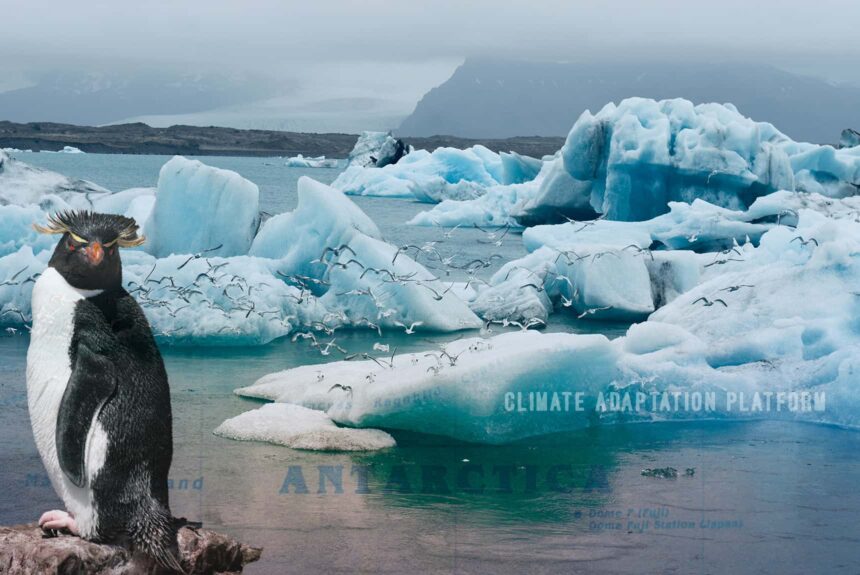For decades, scientists have observed that the Antarctic warming rate is much faster than the global average. But this year, research scientists aboard the ships along the west coast of the Antarctic are seeing an extraordinary warming and record-low sea ice cover.
The scientists of the Palmer Long Term Ecological Research program collect data on penguin feeding and on the Southern Ocean and its ice.
Inside Climate News reports of a relentless ocean warming on the coast of West Antarctica that could likely disrupt a critical part of the global climate system and speed up sea level rise.
According to the article, the program’s chief scientist and a University of Delaware oceanographer, Carlos Moffat, is astonished at the southern ocean’s warming.
“Even as somebody who’s been looking at these changing systems for a few decades, I was taken aback by what I saw, by the degree of warming that I saw,” he said. “We don’t know how long this is going to last. We don’t fully understand the consequences of this kind of event, but this looks like an extraordinary marine heatwave“, Moffat says.
He added that if warming continues, it could destabilise Antarctica’s critical support of the global climate system, including ice shelves, glaciers, coastal ecosystems and ocean currents.
Moffatt says that ocean warming is too early to attribute to climate change until some peer-reviewed results are published but notes that the warming they have observed since April 2022 has been unprecedented.
Scientists have recorded temperature readings in the area that covers 600 miles long and 125 miles wide, documenting widespread ocean heating.
Moffat notes how tough to warm the ocean, and when they see this dramatic ocean heating, it means that a very intense force is at play. And this intense forcing is caused by burning fossil fuels warming the atmosphere and the oceans.
Johan Rockström, director of the Potsdam Institute for Climate Impact Research, explains the dangerous climate feedback cycle of warmer oceans melting the Antarctic ice from below.
The dramatic ocean heating and melting of the sea ice in the Antarctic was surprising to scientists, including Rockström, who thought that the sea ice in the northern hemisphere, like Greenland and the Arctic, was more vulnerable until ten years ago.
The IPCC assessment, released in 2014, shows a tipping point that will trigger the irreversible melting of ice shelves and glaciers in Antarctica at a temperature rise of 1.5℃ and 2℃. The Paris Agreement was ratified the following year to keep temperatures within this range.
The article cites a study that shows the effects of climate change on the system of global currents in recent decades that leave more warm water in the Southern oceans causing marine heatwaves. According to the study, the wave systems flowing northward from the Antarctic toward the Gulf stream have slowed by 15%, retaining warmer surface water in Antarctica.
The warming of the east Antarctic Ocean will continue to intensify, threatening the ice sheet’s future stability. A study in August 2022 that the article mentioned shows that “circumpolar deep water” at a depth of 1,000 to 2,000 feet has warmed by up to 2 degrees Celsius, which is in turn related to a poleward shift of the westerly wind belt. The authors wrote that warming throughout the world’s oceans would continue to persist in the coming decades.
Another study shows the strengthening of the Southern Hemisphere Westerlies (SHW) due to the increasing GHG emission (Deng, Molina, et al., 2022).
Deng, Molina, et al. (2022) mention the following:
- Also known as the roaring 40s, strong westerly winds in the southern hemisphere between the latitudes of 40°S and 50°S partly due to the lack of landmasses that serves as the windbreaks at those latitudes.
- The study states that “changes in strength and position of the SHW could exert huge impacts on global climate, regional weather extremes, ocean circulation, and the carbon uptake and heat transport in the SH oceans.”
- “A poleward shift of moisture-bearing SHWs may lead to reduced rainfall and more frequent droughts in Southeast Australia, stronger winds in New Zealand, warmer ocean surface and higher sea levels in the Tasman Sea, faster ice retreat in Patagonia and demise of the sub-Antarctic glaciers” among other consequences.
- The study findings reveal the importance of implementing global climate policies that will ambitiously slash carbon emissions; otherwise, it will risk causing a series of extreme weather events.
Berwyn (2023) mentions a 2016 study that “outlined a worst-case scenario in which warming would contribute to a rapid break-up of towering ice cliffs near the shore in a process that could speed up sea level rise, raising the water up to 7 feet by 2100 and 13 feet by 2150, increases that would be very hard to adapt to.”
The ocean and the atmosphere interact with one another. Where the ocean’s surface meets the air, an exchange of gases, particles, and heat occurs. This exchange plays an important role in regulating the global climate (As the planet warms, 2023).
The studies cited in the articles show that increasing GHG emissions are warming the atmosphere and the oceans. They also say that warming oceans not only speeds up sea ice melts in both the Arctic and the Antarctic but it influences the global weather system and the system of currents, which can accelerate more ice melts, contributing to the planet’s warming and increasing sea levels which will intensify and make more frequent extreme weather events.
Source:
Berwyn, B. (2023, February 12). Antarctic Researchers Report an Extraordinary Marine Heatwave That Could Threaten Antarctica’s Ice Shelves. Inside Climate News. Retrieved from https://insideclimatenews.org/news/12022023/antarctic-ice-shelves-marine-heatwave/
Deng, K., Molina, C., Yang, S. Hu, C., Zhang, G., Minola, L. & Chen, D. (2022, June 22). Changes of Southern Hemisphere westerlies in the future warming climate. Science Direct. Retrieved from https://www.sciencedirect.com/science/article/pii/S0169809522000266?via%3Dihub
As the planet warms, so does the ocean. (2023). Antarctic and Southern Ocean Coalition. Retrieved from https://www.asoc.org/learn/heating-oceans/



Leave a Reply